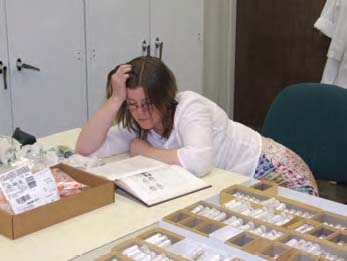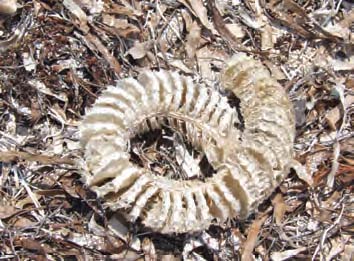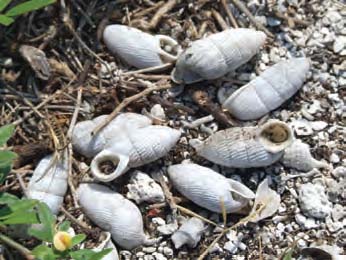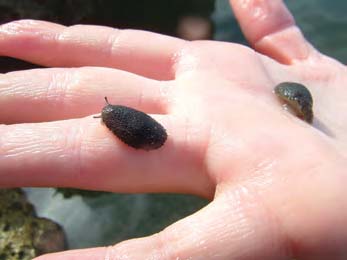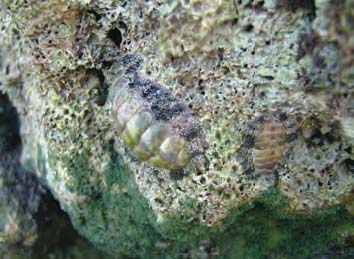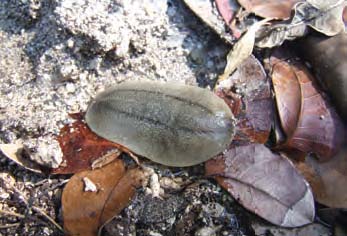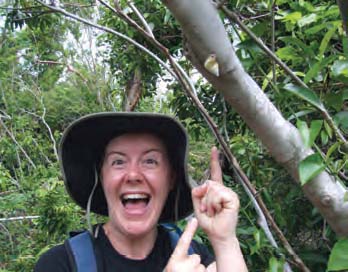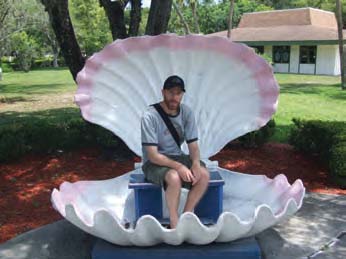|
Last year my wife Eileen and I were lucky enough to spend close to three weeks in the south of Florida, during that time we had many mollusc encounters. We travelled up to Gainesville early on in the holiday to take advantage of the University of Florida’s Natural History Museum collections. I had been in touch with the malacology collections manager, John Slapcinsky, and he had kindly agreed to show me around their stores and let me examine some specimens. Their collections were beautifully organised and I soon found the genus for which I was looking. In a previous article for Mollusc World, I mentioned that whilst in Trinidad I had found a Gastrocopta shell that I had been unable to identify further. I had hoped it was a previously undescribed species but after careful comparison with other specimens I concluded it was Gastrocopta rupicola - the Tapered Snaggletooth. Through all this time my ever so patient wife had been waiting trying, but failing, to interest herself in some of the mollusc related literature. (Fig.1) Heading south from Gainesville we ended up on Sanibel Island on the Gulf coast. The Bailey-Matthews Shell Museum on the island should be the ultimate destination of any conchologist. With R. Tucker Abbott as the founding director the museum got off to a great start. The museum opened in 1995 and has established itself as a popular resource for research and education. As well as displays of shells from all around the world there are a wide range of human objects showing how people through the years have used shells. One of the main displays is about the Calusa, an extinct local tribe of Native Americans who were heavily dependent on shells for all aspects of their lives so much so that it is said they never went through a stone-age level of development instead going through a shell-age (Fig.2). The beaches on Sanibel Island provided some of the best shell-collecting I have ever experienced. Hardly anything alive but the empty shells washed up on the shore and in the shallows were amazing. As the locals love to point out I, like many visitors, had adopted the ‘Sanibel Stoop’ which means walking along the beach bent over looking for shells. Finds included the Florida fighting conch -Strombus alatus, the Florida cone - Conus floridanus, the Banded tulip - Fasciolaria hunteria, the Lettered olive - Oliva sayana and the Common nutmeg - Cancellaria reticulate. One of the highlights of the holiday was a boat trip out to Dry Tortugas National Park, a civil war era fort built on sandbanks and reefs, about 70 miles west of Key West. The snorkelling around the island is fantastic with a great range of corals, sea fans, fish and echinoderms. I didn’t see any live molluscs underwater just an old empty Strombus gigas shell. On the beaches there was a good deal of washed up debris thanks to the Parks strict no collecting rules. One of the more interesting finds was the egg cases of the Lightning Whelk Busycon contrarium (Fig.3) which I had also seen on other beaches all around Florida. On the small area of land there seemed to be an abundance of peanut shells Cerion incanum (Fig.4). I would have liked to bring a few samples back for further study as there are meant to be hybrid versions between the species found originally on the Florida Keys and introduced species from the Bahamas but I was good and followed the no collecting rule to the letter. One of the strangest molluscs I came across was on the rocks on the shore right next to where we were staying in the Keys. At first I had no idea what they were, small dark blobs with a pair of tentacles and rough skin. It was only after I got back home and described them to a colleague that I realised they must have been Onchidella floridana. (Fig.5). The Onchidiidae are Pulmonates, have no gills and no shells, they are generally an intertidal group and can survive on land or underwater. In the same habitat I came across a good selection of other molluscs including Fuzzy West Indian chitons – Acanthopleura granulata (Fig.6), Bleeding Tooth nerites – Nerita peloronta, Zebra periwinkles – Littorina ziczac and Wide-mouthed Purpura – Purpura patula. Just outside the house I was staying in there was a wealth of life in the leaf litter. Whilst carefully avoiding the scorpions I found many Polygyra cereolus shells and one of the few native slugs of Florida - the Florida leatherleaf Leidyula floridana (Fig.7). As the name suggests this slug looks like a leathery leaf and it was only the movement and the presence of tentacles that made it stand out. In the last few days of our holiday we took a trip to the Everglades. As it was the end of the dry season the water levels were low so the air-boat trips that seem almost obligatory were a bit of a disappointment. We did have a very nice walk near one of the visitor centres which had a trail especially set up for Liguus snail spotting. I wasn’t too optimistic because of the time of year and the very dry conditions but we set out anyway. I was having no luck but thankfully my wife soon got her eye in and was spotting them all over the place finding a Liguus fasciatus lossmanicus (Fig.8) Our friend and host, Kim Scheerer, also proved very adept at finding these beautiful tree snails spotting a Liguus fasciatus testudineus form marmoratus (Fig.9). (Although I have given full names for these Liguus species I cannot say for definite that these are correct. As anyone who has studied Liguus will know there is a tremendous amount of variation and as I could not collect the snails and study them more closely I was limited to photographic identification.) One of the weirder places we visited was Weeki Wachee Springs, an old fashioned amusement park with a live underwater mermaid show and the chance to experience what it feels like to be a clam! (Fig.10) All in all Florida provided a fantastic range of molluscs in all sorts of habitats and should be high on the list of holiday destinations for any conchologist. |
Fig 1
Fig 2 Calusa exhibition
Fig 3 Busycon contrarium
Fig 4 Cerion incanum
Fig 5 Onchidella floridana
Fig 6 Acanthopleura granulata
Fig 7 Leidyula floridana
Fig 8 On discovery of Liguus fasciatus lossmanicus
Fig 9 Kim Scheerer
Fig 10 A bit of fun at Weeki Wachee Springs
|
Molluscs in South Florida
Issue
13
Page
21

